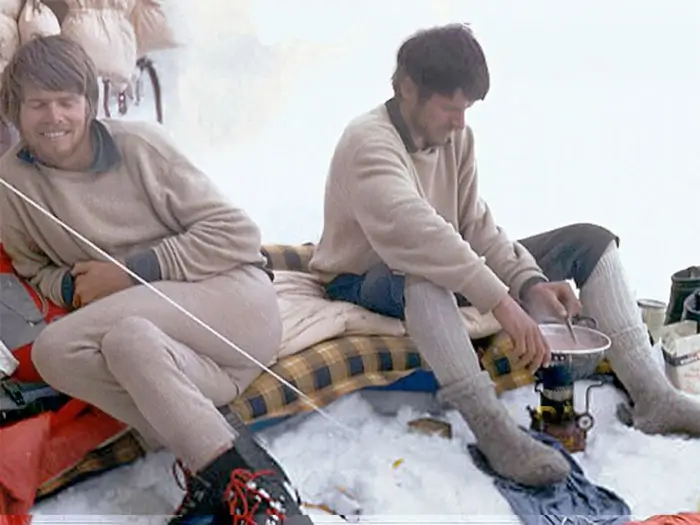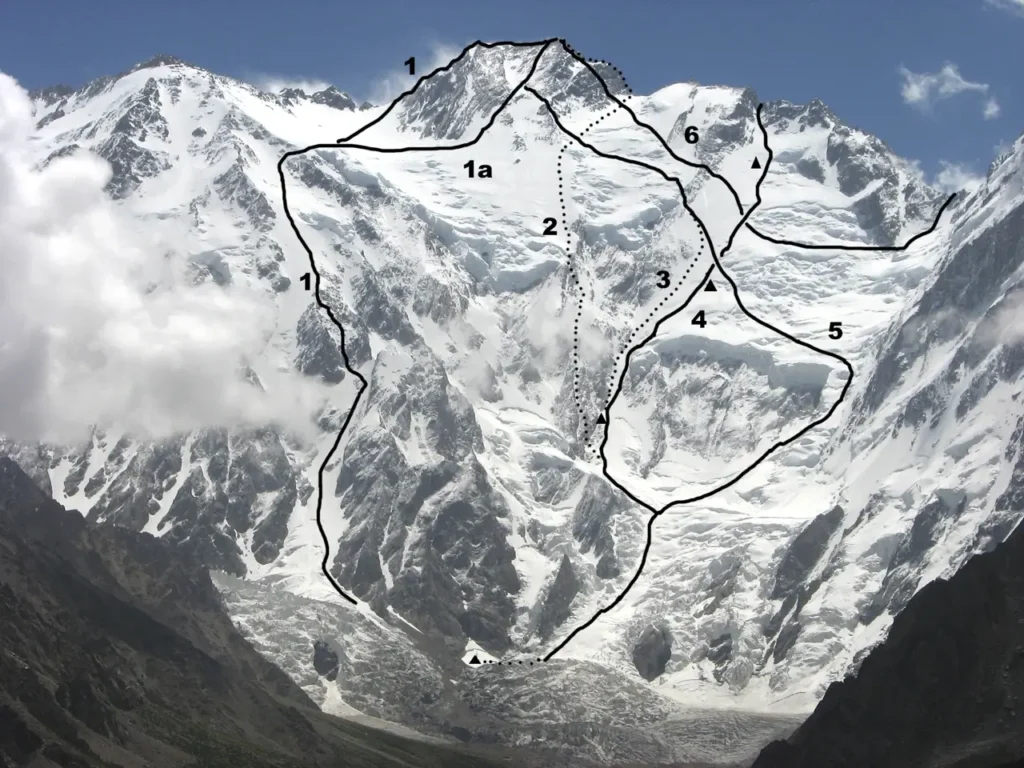Messner Brothers’ Tragic Nanga Parbat Climb Explained
In the world of mountaineering, some stories rise above the rest – not just for the peaks conquered, but for the human depth, tragedy, and pioneering spirit they reveal. The story of Reinhold and Günther Messner’s 1970 expedition on Nanga Parbat is one of the most extraordinary and heartbreaking in climbing history. It is not just another summit story – it is a defining moment that reshaped the future of high-altitude climbing and left a lasting imprint on generations of climbers.

Possibly the last photo of the Messner brothers, Reinhold (left) and Guenther, at Nanga Parbat’s Camp 5.
Nanga Parbat, known as the “Killer Mountain,” has long been one of the most dangerous and unforgiving peaks in the world. In 1970, a German expedition led by Karl Herrligkoffer set out to climb it via the immense Rupal Face, the highest mountain wall on Earth. Among the team were Reinhold Messner (26), already earning acclaim from bold alpine climbs in the Dolomites, and Günther (24), his determined yet less seasoned rope partner, found themselves thrust into one of the most audacious mountaineering attempts ever attempted. What made this expedition so unique was not just their route or their ambition, but the radical decisions and unforeseen tragedy that unfolded.
On June 26, as they reached Camp V at 7,200 m, Herrligkoffer signaled with a red rocket – traditionally a warning of incoming storm – though later reports suggested the forecast was mistaken. Reinhold, trusting his instincts, left alone at around 2:00 a.m. to push for the summit before weather worsened. Günther impulsively abandoned his rope fixing duties and sprinted after him, ultimately catching Reinhold in the Merkl Couloir. Late in the afternoon of June 27, the brothers stood atop the summit – a triumphant yet perilous achievement

With no daylight or energy to retrace the Rupal Face, they bivouacked in scant shelter and made the daring decision to descend via the uncharted Diamir Face. In doing so, they completed the first-ever traverse of an 8,000-meter peak. Over the next two days, they crawled down, both frostbitten and exhausted. At a point on the Diamir, they became separated: Reinhold pressed on, but Günther lagged behind. He vanished – apparently swept away in an avalanche. Reinhold, near death, stumbled into the valley, losing seven toes to frostbite, and was rescued by shepherds
Back at base camp, controversy erupted. Fellow climbers, including Hans Saler and Max von Kienlin, accused Reinhold of abandoning his younger brother for fame on Diamir side. Debate and legal actions ensued, fueled by conflicting accounts and Reinhold’s decision to descend contrary to Herrligkoffer’s plan
But in 2005, a breakthrough finally came. A boot and human remains were found on the Diamir Face glacier, confirmed through DNA to belong to Günther Messner. This discovery strongly supported Reinhold’s long-held account of their descent. In 2022, a second boot was recovered and returned to Reinhold – a moment of deeply personal closure more than 50 years after the tragedy. Reinhold later reflected that their choice had been simple: remain and die, or traverse and survive. His quote,
“We had a choice between waiting for death and going out to meet it,” has echoed in mountaineering lore.
What makes the Messner brothers’ Nanga Parbat expedition truly legendary is not just its firsts, but its raw humanity. It was the first traverse of an eight-thousander, achieved in minimalist alpine style, without oxygen, fixed ropes, or large teams. It is a story of brotherhood, of the price of boldness, and of the mountain’s brutal unpredictability. It is also a story that the mountain itself, over decades, slowly revealed to be true.
Despite losing seven toes to frostbite, Reinhold Messner went on to become one of the greatest mountaineers of all time. He completed all fourteen 8000-meter peaks without supplemental oxygen and set the standard for pure, lightweight climbing. He has since worked to honor Günther’s memory, including supporting education projects in the Diamir region. His book The Naked Mountain and the film Nanga Parbat share his perspective on the climb, while the debate surrounding this expedition has been widely discussed in other books and documentaries.

Today, the Messner brothers’ expedition stands unique: it was the first traverse of a Himalayan 8,000er, accomplished in a minimal, alpine style, at great cost. It is a story of daring innovation, brotherly love, collapse, and redemption – finally corroborated by glacier finds more than half a century later. At Summiters Club, we honor their legacy as the fitting start to our series on the world’s most pivotal expeditions.
